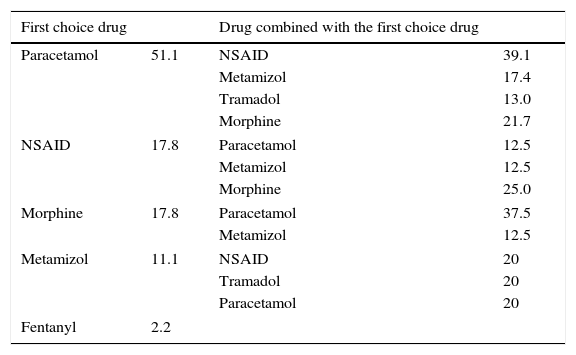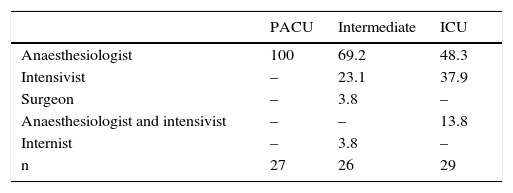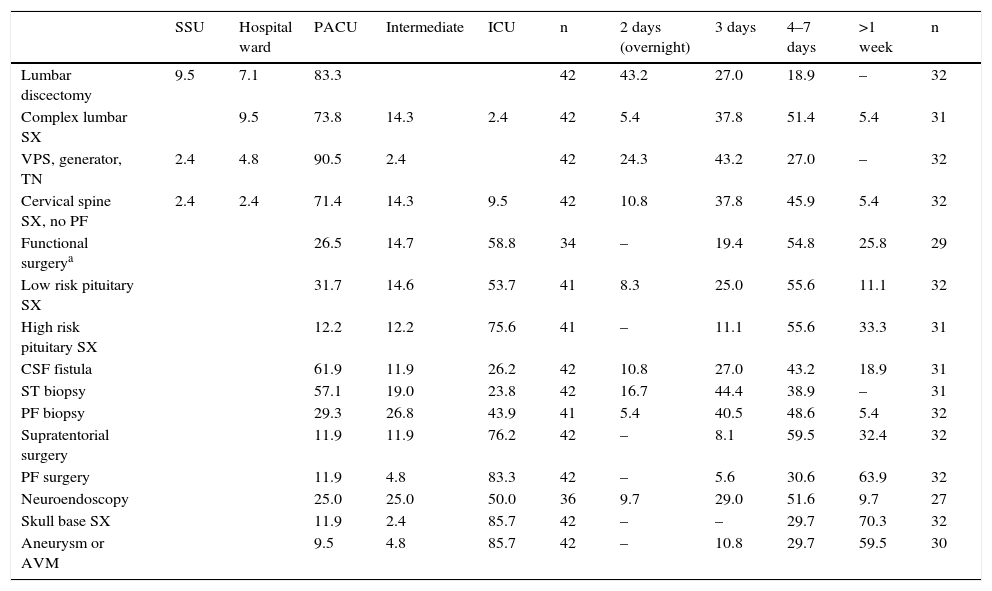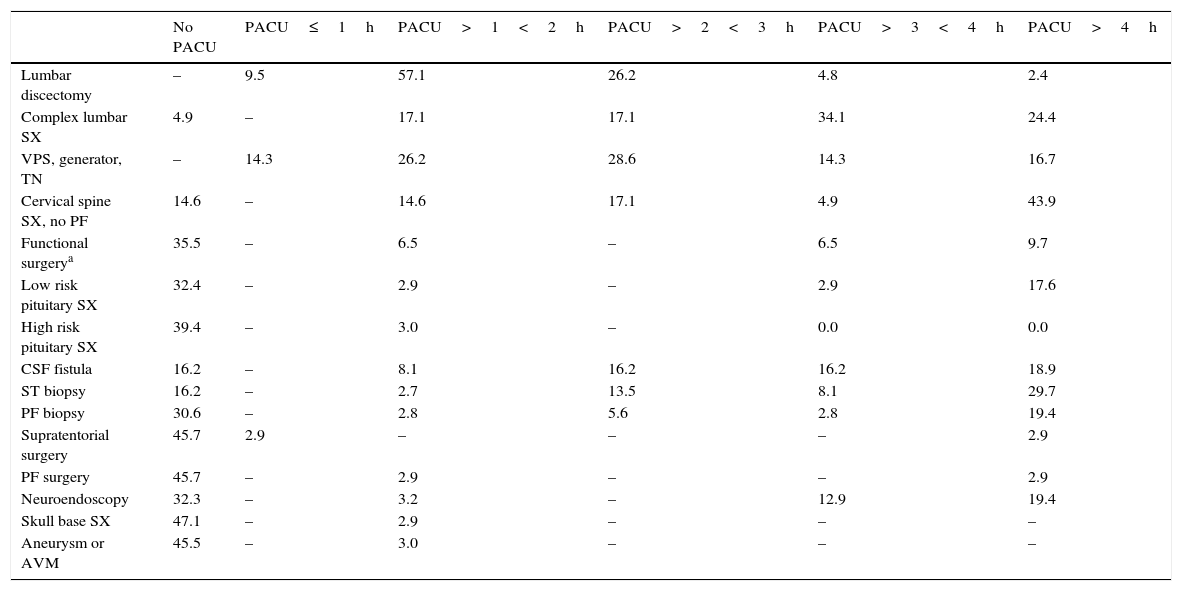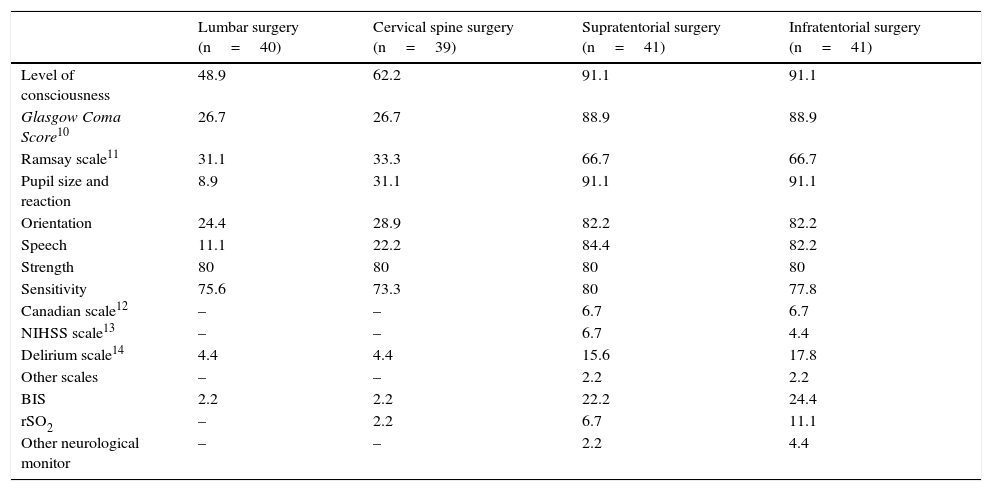The analysis of surgical processes should be a standard of health systems. We describe the circuit of care and postoperative treatment for neurosurgical interventions in the centres of our country.
Material and methodsFrom June to October 2014, a survey dealing with perioperative treatments and postoperative circuits after neurosurgical procedures was sent to the chiefs of Anaesthesiology of 73 Spanish hospitals with neurosurgery and members of the Neuroscience Section of SEDAR.
ResultsWe obtained 45 responses from 30 centres (41.09%). Sixty percent of anaesthesiologists perform preventive locoregional analgesic treatment. Pain intensity is systematically assessed by 78%. Paracetamol, non-steroidal anti-inflammatory and morphine combinations are the most commonly used. A percentage of 51.1 are aware of the incidence of postoperative nausea after craniotomy and 86.7% consider multimodal prophylaxis to be necessary. Dexamethasone is given as antiemetic (88.9%) and/or anti-oedema treatment (68.9%). A percentage of 44.4 of anaesthesiologists routinely administer anticonvulsive prophylaxis in patients with supratentorial tumours (levetiracetam, 88.9%), and 73.3% of anaesthesiologists have postoperative surveillance protocols. The anaesthesiologist (73.3%) decides the patient's destination, which is usually ICU (83.3%) or PACU (50%). Postoperative neurological monitoring varied according to the type of intervention, although strength and sensitivity were explored in between 70 and 80%.
ConclusionsThere is great variability in the responses, probably attributable to the absence of guidelines, different structures and hospital equipment, type of surgery and qualified personnel. We need consensual protocols to standardise the treatment and the degree of monitoring needed during the postoperative period.
El análisis de los procesos quirúrgicos debe ser un estándar de los sistemas de salud. Describimos el circuito de atención y tratamiento postoperatorio para intervenciones neuroquirúrgicas en los centros de nuestro país.
Material y métodosDesde junio a octubre de 2014 se difundió una encuesta a jefes de Anestesiología de 73 hospitales españoles con neurocirugía y a miembros de la Sección de Neurociencia de la SEDAR, sobre tratamientos perioperatorios y sobre los circuitos postoperatorios tras procedimientos neuroquirúrgicos.
ResultadosObtuvimos 45 respuestas de 30 centros (41,09%). Un 60% de los anestesiólogos realiza tratamiento preventivo analgésico locorregional; la intensidad del dolor es evaluada sistemáticamente por un 78%. Las combinaciones de paracetamol, antiinflamatorios no esteroideos y morfina son las más utilizadas. Un 51,1% conoce la incidencia de NVPO tras craneotomía y el 86,7% considera necesaria la profilaxis multimodal. La dexametasona se administra como antiemético (88,9%) y/o tratamiento antiedema (68,9%). Un 44,4% de los anestesiólogos administra sistemáticamente profilaxis anticomicial en pacientes con tumores supratentoriales (levetiracetam, 88,9%). El 73,3% de los anestesiólogos disponen de protocolos de vigilancia postoperatoria. El anestesiólogo (73,3%) es quien decide el destino del paciente, que suele ser UCI (83,3%) o URPA (50%). La monitorización neurológica en el postoperatorio varió según el tipo de intervención, si bien la fuerza y la sensibilidad se exploraron en el 70-80%.
ConclusionesExiste una gran variabilidad en las respuestas, probablemente atribuible a la ausencia de guías, diferentes estructuras y equipamiento hospitalario, tipo de cirugía y personal cualificado. Necesitamos protocolos consensuados para estandarizar el tratamiento y el grado de monitorización necesaria durante el postoperatorio.





